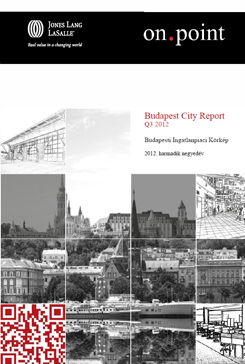Budapest City Report, Q3 2012
Report Authors: Jones Lang LaSalle
Report Summary:
ECONOMY/INVESTMENT
Economy: The discussions between the Hungarian government and the IMF/EU have been progressing very slowly. Although according to original plans, an agreement on a financial assistance package was expected around October 2012, so far it seems that negotiations might extend into 2013 as currently, there is no fixed scheduled date to continue talks with the delegation. Although several austerity measures have been announced by the government to reduce the budget deficit, the IMF is waiting for structural measures, which support the decrease of the deficit in a sustainable manner while generating growth.
OFFICE MARKET
Supply: In Q3 2012, the modern office stock in Budapest stood at 3,175,800 m2. Out of this space, 2,622,220 m2 are speculatively built offices, with the remaining 553,580 m2 being owner occupied offices. Similarly to the previous quarter, no new office building was delivered between July and September. Despite this, availability continued to increase for the third consecutive quarter and stood at 21.5%. This means that the total market vacancy rate grew by more than 30 bps q-o-q, by almost 80 bps y-o-y and is nearly as high as it was in Q3 2010 when it peaked at 21.6%. This is especially worrying taking into account the fact that only one smaller speculative office building was completed so far in Budapest (IQ Offices on 2,350 sq m in Q1 2012).
RETAIL MARKET
Supply: Similar to the previous quarter, no new retail project has been handed over in Budapest in Q3 2012. Therefore, the total shopping centre stock of the capital remained unchanged at 772,500 m2 in 28 assets. Shopping centre density is equal to 448 m2 / per 1,000 inhabitants in Budapest. The current regional shopping centre stock equals 556,700 m2 in 37 centres. Similarly to Budapest, no new shopping centre has been completed in the regions. In terms of vacant retail units, there is a significant difference between the top performing and the less successful shopping centres in Budapest. There are not many retailers who are willing and able to expand and, they are only focusing on the best retail schemes. There is a clear difference in the tenant mix of the respective shopping centres as well. High-end brands tend to be located in only the best performing schemes, while down-market brands are mainly found in shopping centres with less wealthy catchments.
INDUSTRIAL MARKET
Supply: In Q3 2012, the modern industrial stock in greater Budapest stood at 1,806,485 m2. Similar to the rest of 2012, no new warehouses were completed in Q3 2012. Most of the industrial space accounts for logistics parks ca. 91% (1,637,040 m2) while city logistics schemes represent a mere 9% (169,450 m2).
About the Author:
Today's changing real estate market dynamics and the volatile world in which our industry operates require knowledge and intelligence to create competitive advantage like never before. Jones Lang LaSalle's industry-leading research group delivers market analysis and insights that drive value in real estate decisions and support successful strategies for clients.
